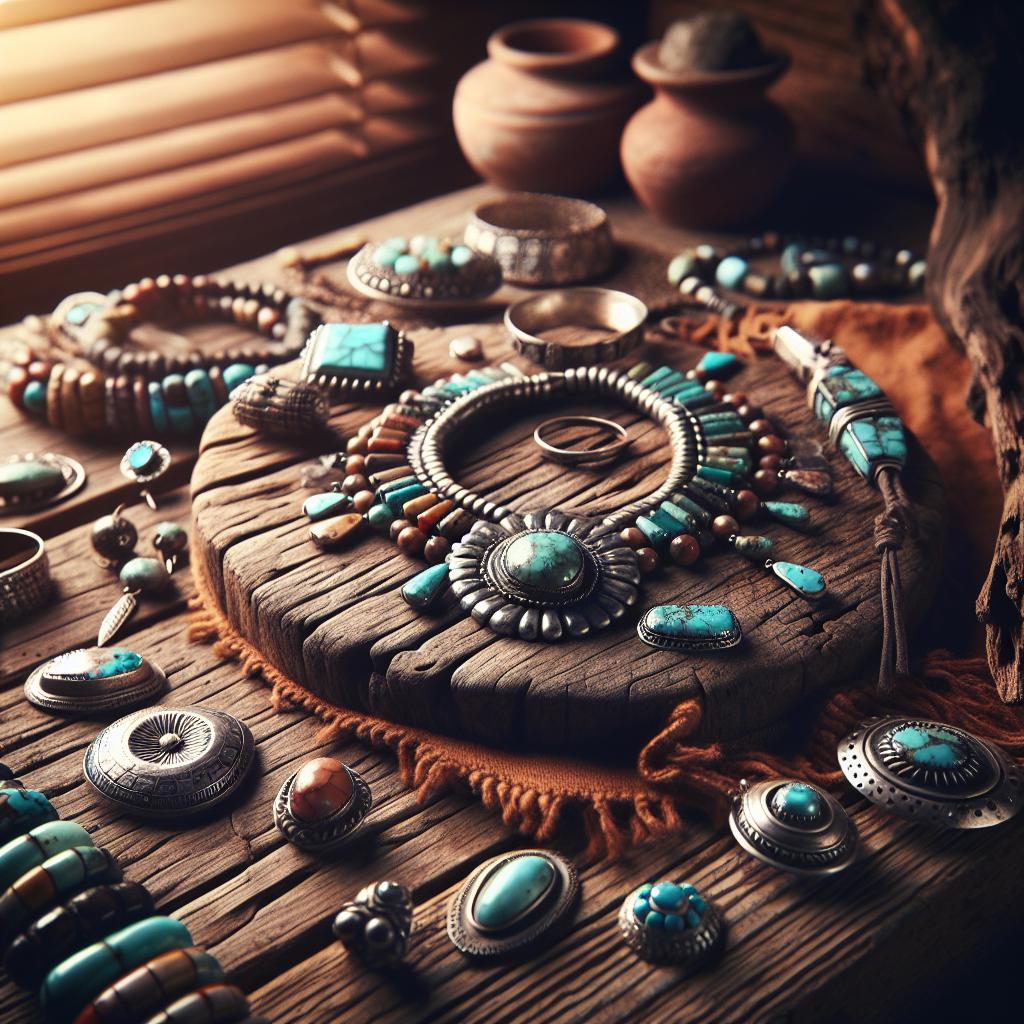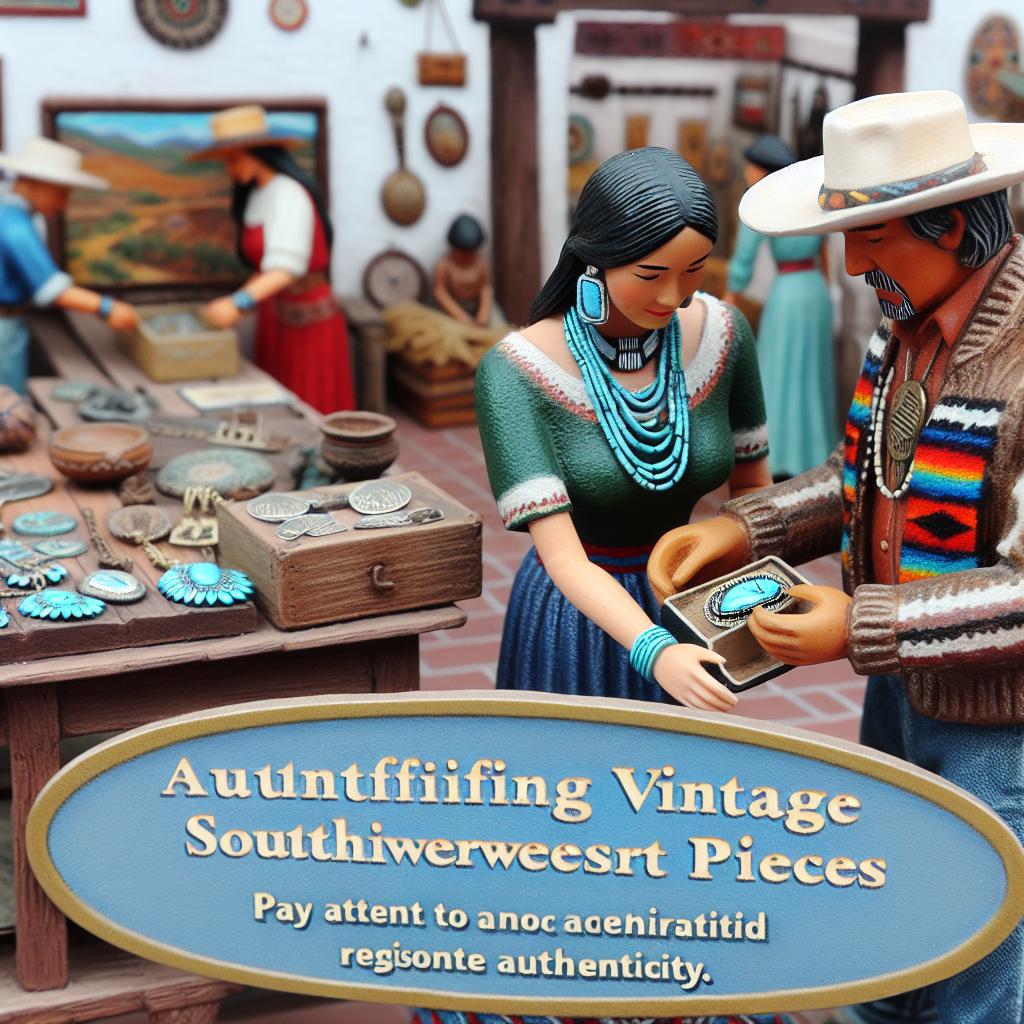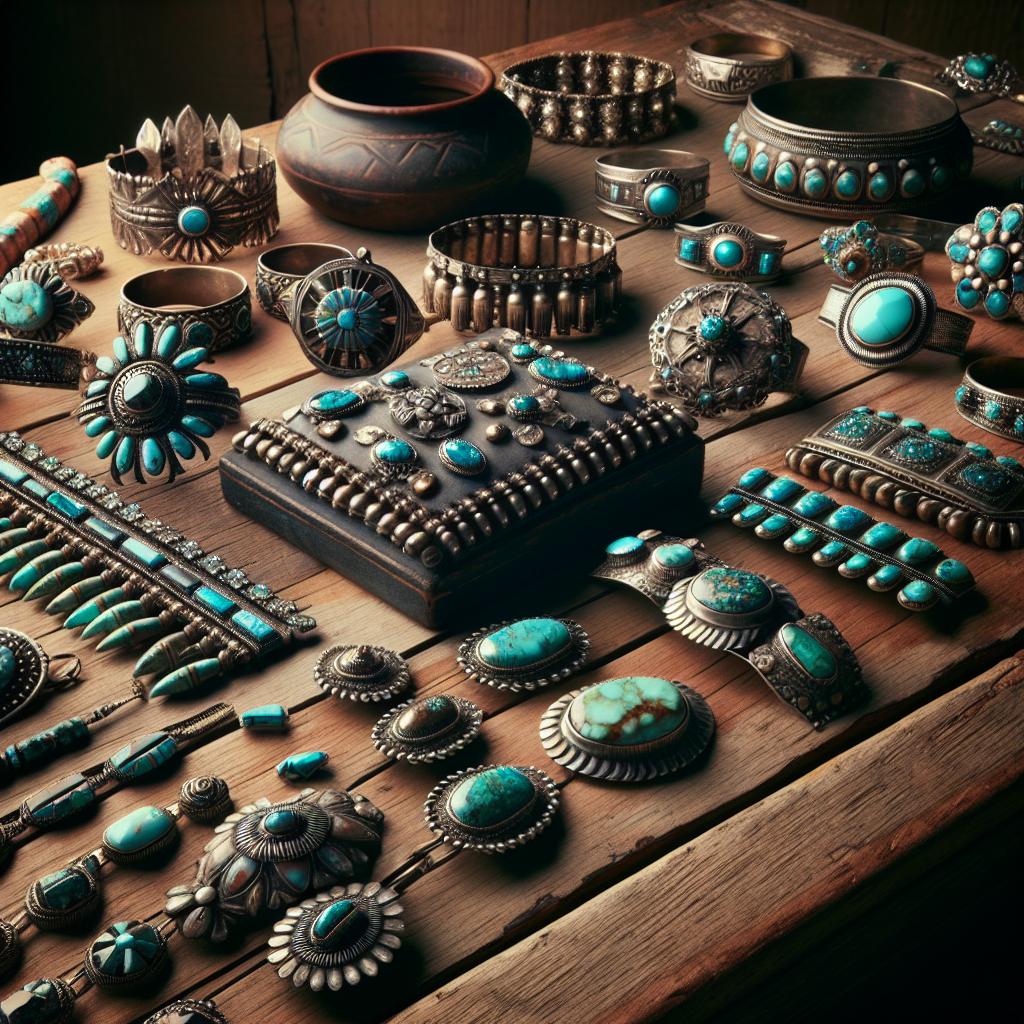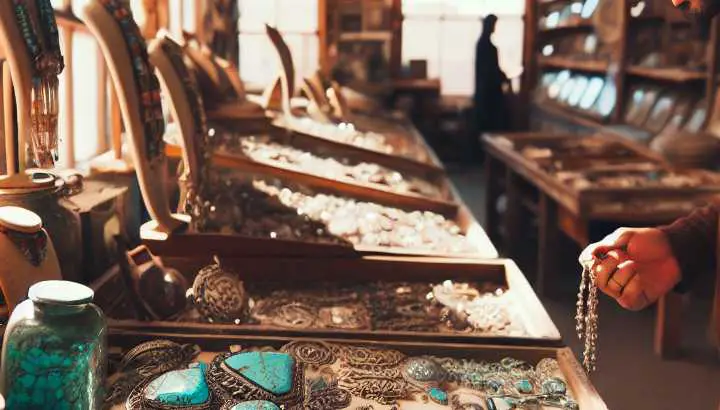Collecting Vintage Southwestern Jewelry

1. History and significance of vintage southwestern jewelry
Pioneering souls, buckle up! We’re about to embark on a wild, whimsical, and (somewhat) mythological journey back in time. Our destination? The heart-stirring, soulful, awe-inspiring domain of vintage southwestern jewelry. Clasp your turquoise-studded necklace, don your silver rings, and tighten your concho belts, because things are about to get dustier than an old cowboy’s boots!
From the moment Native American artisans first coaxed gleaming jewels from rough-hewn stone, the southwestern jewelry scene has been as vibrant and varied as a desert sunset. Crafted using materials unique to the region, this flamboyant chunk of history has adorned the dusty plains like a fabulous, shiny beacon of artistic excellence.
Alright, let’s cowboy (or cowgirl) up and take a gander at the origins of this dramatic jewelry spectacle. The dust-edged journey of southwestern jewelry began thousands of years ago (that’s even before your great-great-great-grandpappy was a glint in his daddy’s eye!) with the Native American tribes of the American Southwest. These early craftsmen were like real-life alchemists with a better fashion sense, because instead of turning base metals into gold, they transformed raw resources like turquoise, coral, and silver into intricate adornments that still make modern jewelry seem ho-hum—talk about serious throwback style goals!
Imagine returning home from a day out hunting, gathering, and generally surviving, and deciding the perfect way to unwind was, not with a drink, or sinking into a comfortable chair, but meticulously crafting intricate wearable art. That, my dear readers, was the level of dedication these artisans possessed.
Turquoise, with its heavenly hue of blue-green, was seen as the ‘IT’ item—it was the Gucci of the Stone Age if you will. So dazzling was turquoise that many tribes saw it as a direct conduit to the skies, a perfect slice of heaven in earthly grasp. Silversmithing was also a big deal brought in by the Navajo from the Spanish in the 19th century.
“When you see the Princess Helena you will envy her the new shapes of dresses and jewelry”
~ James M. Ludlow, Deborah
Cue the inception of all that gorgeously lustrous silver-jewelry rioting blithely across the landscape!
Now that we’re done traipsing about the roots of vintage southwestern jewelry, let’s yammer about its significance. Apart from oozing distinctive character and personality (not unlike your eccentric Aunt Gertrude), each piece was also believed to carry with it a certain spiritual essence, with specific symbols and stones dedicating to blessing, protecting, healing, or even foretelling the future – way more helpful than the vague fortune cookies we get these days!
Vintage southwestern jewelry is also the emblem of soul-stirring stories. It served as a visual chronicle of the tribe’s history, beliefs, and legends. For instance, bear symbols were for strength, feathers were for prayers, and arrowheads for protection – they make modern emojis seem rather basic by comparison!
So, why is vintage southwestern jewelry still such a hankering theme for the fashion-forward, the collectors, and basically anyone with a keen eye for dazzling aesthetics? Well, it’s simple. These alluring embodiments of earth and spirituality offer a striking blend of art, history, and mystic charm that transcends the bounds of time – the perfect amalgamation of the ancient and the avant-garde. And let’s not forget the craftsman’s timeless yee-haw spirit that lies at the heart of every piece.
From its rich Native American history to its continued influence on contemporary jewelry trends, vintage southwestern jewelry is far more than items of adornment. They are cultural artifacts, historical chronicles, and artistic masterpieces that reflect love, honor, spirit, and resilience—a real testament to the enduring allure of self-expression.
So, next time you drape a turquoise necklace around your neck, remember, you’re not just accessorizing; you’re echoing a spectacular history, a time-honored tradition, and a fat chunk of gutsy spirit that goes with it!
Read More: 1. History And Significance Of Vintage Southwestern Jewelry

2. Tips for identifying authentic vintage southwestern pieces
Welcome, avid antiquarians, passionate plunderer of yore, and curious kitsch-collectors! We’re about to embark on a thrilling treasure hunt as we discern the truly valued relics of the southwest from dastardly decoy dodos. So, grab your metaphorical magnifying glass, don your detective’s hat and prepare for action. In this enchantingly engaging guide, we’ll drop some vital wisdom nuggets to help you identify authentic vintage southwestern pieces.
Sharpen those eagle eyes and let’s delve into the sepia-tinged past with tip#1: distinctive design and craftsmanship.
1. Distinctive Design & Craftsmanship – Play Sherlock!
Why not channel your inner Sherlock Holmes as you carefully examine the design and craftsmanship of a piece? But, stay restrained! Jumping at the first hint of a cactus design is akin to believing every bigfoot sighting. It’s not about ‘what,’ it’s about ‘how.’
The Southwest is brimming with a rich tapestry of history, tradition, and diverse cultures. The influence of Native American, Hispanic, and Anglo cultures are knitted intricately within the artistic tapestry. Be on the lookout for pieces that scream the unique aesthetic mix of these cultures.
Steer clear of cluttered, vague designs! Southwestern vintage pieces are renowned for their clean lines, geometric shapes, coupled with vivid, earth-toned colors. Turquoise, red, yellow, brown – if it ignites nostalgia for sunset over a vast desert plateau, you’re likely on the right track. The exquisite craftsmanship of these pieces often includes Native American motifs such as arrows, feathers, and mesas.
Still doubting if you’ve got a Picasso or a carpet-bagger’s concoction? Let’s swim against the current to tip #2: Check out the materials used.
2.
“Quite in contrast to all this, a lock of hair hung down the middle of her forehead, to which were tied pieces of garlic and various other charms to ward off the evil eye”
~ Demetra Vaka, A Child of the Orient
Examining the Materials – It’s Not all Glitter and Gold
Well, sometimes it is gold. And silver. And turquoise. If ever you’ve dreamt of being a glamorous geologist, here’s your chance. Authentic southwestern pieces, especially jewelry, often incorporate sterling silver and turquoise.
Let’s talk about turquoise, the MVP of southwestern vintage world. This enchanting semi-precious mineral often varies in color from sky-blue to grass-green depending upon the copper and iron content. Genuine turquoise tends to change color over time, developing an alluring vintage patina that would make even the fashionistas at Vogue weak in the knees.
However, beware the villain in our story – faux turquoise! The market’s teeming with an imitation turquoise (sometimes plastic, oh the horror!) masquerading as the real deal. Spot the difference by looking for plastic-y shine, uniform color without veins or imperfections, suspiciously lightweight, or unscrupulous prices that are as laughable as a chinchilla running for president.
Voila! Now you are armed to the teeth with keen know-how for identifying authentic vintage southwestern pieces.
Remember dear reader, patience is key in this pursuit of history. So, take your time, enjoy the hunt, and let yourself be swept away in a whirlwind of intrigue and mystery as you play Indiana Jones in your local antique store. It’s not just about the ‘find’; it’s about the stories, the adventure, and the connection to the past woven into each unique piece. Good luck, savvy scavenger of the past! Go forth and conquer the dusty, cobwebbed realms of forgotten grandeur.
Learn More: 2. Tips For Identifying Authentic Vintage Southwestern Pieces

3. Caring for and maintaining your vintage southwestern jewelry collection
Title: The Wild West of Vintage Southwestern Jewelry: Three Stellar Care Tips
Think of it this way: your vintage southwestern jewelry collection is like a decades-old cactus. It’s prickly, teeming with character, and (assuming you’re not smuggling cacti) it adds a tangible touch of Wild West to your contemporary world. Regardless of their worth in dollars (though some pieces could probably pay for a lifetime supply of cowboy boots), these baubles and beads deserve – nay, demand – a McCree level of care. So saddle up, partner! We’re about to whip out the shotgun of information to restore the shine to your antique treasures.
**1. The Showdown with Tarnish:**
Your grudge match with tarnish might seem as bleak as a shootout at noon – but fear not! These timeless pieces of art aren’t as frail as a tumbleweed in a rodeo. Most of this hearty jewelry is crafted from sterling silver, designed to weather stormy relationships, bar fights, and even a little neglect.
However, years of disuse can usher in nasty tarnish that threatens to douse the fire of your vibrant Turquoise or squash the spirit of your Coral. So, tip number one: invest in a gentle, non-abrasive silver polish. Note: ‘GENTLE’ is the operative word here – you’re cleaning jewelry, not scrubbing an old hitching post.
Remember, each piece of jewelry is unique – like your Grandma Wildfire’s chilli recipe – so apply a minor test dab to an unobtrusive area first. If you notice any untoward color changes or the distinct sound of your jewelry sobbing in despair, abort mission. This is where professional cleaning comes in to save the day (or the jewelry, to be precise).
**2. More Pearls Than a Saloon Girl’s Wardrobe:**
Pearls are the misunderstood protagonists of the jewelry world. A pearl necklace or a string of pearl baubles nestled among your vintage jewelry might come off as fancier than a coyote in a feather boa. But, they’re not divas.
“BLOOD-STAINED CONFEDERATE BATTLE-FLAGS, CAPTURED DURING THE 462 WAR, Sketched by permission of the Government from the large collection in possession of the War Department, at Washington”
~ Mary
Clemmer, Ten Years in Washington
In fact, they love the human touch! Bodily oils help maintain their moisture and luster. Who knew?
Just take care to avoid direct contact with perfumes, lotions, or remnants of that ranch-style barbeque. After wearing them, clean your pearls gently with a soft, damp cloth. And remember, string pearls when dry. Wet stringing is just asking for string stretch, which – in the world of pearl care – is about as welcome as a rattlesnake in a square dance.
**3. Dry Spell Storage:**
Think about it: southwestern pieces were born in sizzling heat, open plains, and rattlesnake dens. They’re as thirsty as a cowboy after a long cattle drive. So, while our delicate jewels may require a cool, dark, and moisture-free haven, our Stetson-tough vintage pieces can handle a bit of the dry life.
Store these pieces separately in humidity-controlled environments or anti-tarnish pouches if you’re feeling fancy. Just make sure they’re not crowded together like bandits in a jail cell; they need room to breathe.
Your vintage southwestern collection is a monument to a timeless culture, a tribute to the untamed spirit of the desert. It’s as enduring as a moonlit mesa and as precious as water in a desert. But like the fine balance of spices in a campfire chilli, it needs to be maintained with love and care. So, go ahead. Mind these tips and you won’t need to ride into the sunset to find gleaming, well-looked-after vintage baubles. They’re right there, in your cherished collection.
